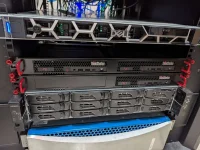Okay I am down to networking for my planned cluster and before I buy the "stuff", I wanted to check in and make sure I'm not forgetting something or under/over purchasing for my needs.
I have 3 Minisforum MS-01 w/ the Intel 13 i9 cpu / 96GB ram / Samsung enterprise 7.6TB U2 ssd (Ceph) / 2TB M.2 (for OS). They have two 2.5gps and two 10gps ports and an empty PCIe 4 8x open slot.
For the Ceph private network I was planning on using a MikroTik CRS504-4XQ-IN (4 port 100gps)
For the Ceph public I was thinking of another MikroTik CRS504-4XQ-IN but I'd need a dual 100gps PCIe x8 Nic card and I'm, not sure that's realistic (heat may be an issue too).
For the Promox Corosync I thought one of the 2.5gps ports to a cheap 4 port switch would be fine.
For the VMs/Containers and backup server CRS309-1G-8S+IN (8 ports at 10gps)
For the dual 100gps Nics, Mellanox MCX516A-CCAT ConnectX-5 EN is a PCIe 3 x16 and I "think" that is "basically" the same as a PCIe 4 x8.
I can save money if 25gps is enough for the 3 OSDs of Ceph I'm panning on. I can get easily find a dual 25gps Nic for the nodes. The same seems to be true w/ 40gps used enterprise gear. I'm not interested in full depth rack gear.
I prefer to keep things physical separated and not VLANs for the Ceph/ Corosync networks.
I "think" I have a good plan. I still haven't figured out the PCIe Nics however. I have no experience with MikroTik.
Have I over/under done anything? Am I not thinking of something? Do you have any advice or opinions to share?
Thank You!
I have 3 Minisforum MS-01 w/ the Intel 13 i9 cpu / 96GB ram / Samsung enterprise 7.6TB U2 ssd (Ceph) / 2TB M.2 (for OS). They have two 2.5gps and two 10gps ports and an empty PCIe 4 8x open slot.
For the Ceph private network I was planning on using a MikroTik CRS504-4XQ-IN (4 port 100gps)
For the Ceph public I was thinking of another MikroTik CRS504-4XQ-IN but I'd need a dual 100gps PCIe x8 Nic card and I'm, not sure that's realistic (heat may be an issue too).
For the Promox Corosync I thought one of the 2.5gps ports to a cheap 4 port switch would be fine.
For the VMs/Containers and backup server CRS309-1G-8S+IN (8 ports at 10gps)
For the dual 100gps Nics, Mellanox MCX516A-CCAT ConnectX-5 EN is a PCIe 3 x16 and I "think" that is "basically" the same as a PCIe 4 x8.
I can save money if 25gps is enough for the 3 OSDs of Ceph I'm panning on. I can get easily find a dual 25gps Nic for the nodes. The same seems to be true w/ 40gps used enterprise gear. I'm not interested in full depth rack gear.
I prefer to keep things physical separated and not VLANs for the Ceph/ Corosync networks.
I "think" I have a good plan. I still haven't figured out the PCIe Nics however. I have no experience with MikroTik.
Have I over/under done anything? Am I not thinking of something? Do you have any advice or opinions to share?
Thank You!
Last edited:


